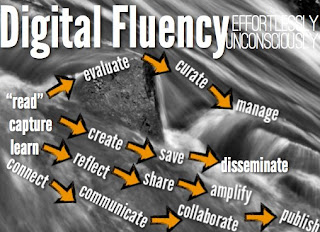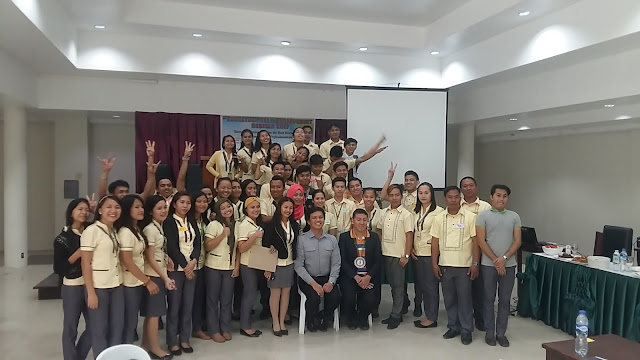21st CENTURY SKILLS: The Six (6) Fluencies.
DIGITAL FLUENCY
We all know nowadays, we live in the 21st century so that they have a lot of changes that we are facing in terms of new technology. Commonly issues nowadays are all about social media, because of digital fluency.Because of social media, the new generation is very popular in using this digital fluency. Because of digital fluency, the students know where and how to find and access information quickly and accurately, they can critique the relevance and accuracy of information being accessed, they can adept producer of digital content, they can recognize and use the most effective methods of reaching their intended audience, they understand and demonstrates how to use digital technologies responsibly including - digital security (self-protection).
CREATIVITY FLUENCY

Creativity Fluency is the process by which artistic proficiency adds meaning through design, art, and storytelling. It is about using innovative design to add value to the function of a product through the form. The process of creativity Fluency is defined by the 5Is.
The 5Is are:
- Identify, This involves distinguishing the elements and the criteria of the desired outcome. It’s about figuring out what you need to create and what limitations or restrictions you face.
- Inspire, In this next stage, the adventure begins by stimulating your creativity with rich sensory input. This involves any action, encounter, or lively conversation that fires your imagination.
- Interpolate, Interpolate means to find a structured pattern within known information. This is all about “connecting the dots” in the search for clear patterns and higher level abstractions within the sensory input.
- Imagine, This is the ultimate synthesis between the previous stages of Inspire and Interpolate. The unification of these stages results in the birth of your idea—your “Aha!” moment.
- Inspect, With our new creative idea now a reality, we ask ourselves questions about the effectiveness and feasibility of the new idea, and if it can be accomplished within an existing timeframe and budget.
SOLUTION FLUENCY

INFORMATION FLUENCY


Is a model that builds on the skills of traditional digital literacy, integrating, technology with the domain (discipline) specific knowledge, critical thinking, presentation, participation and communication skills.
- One of the examples of information fluency is the ability to access information like using Internet, books, magazines, newspaper, cd-room, internet, dictionary.
- Retrieve information, we can teach our children to retrieve our important file because all information is in the USB or on our computer; and
- ability to reflect on and assess, and rewrite all the information.
COLLABORATION FLUENCY

Many of us are focused on the short-term goals (focus on the "now" and getting our students ready for the next day, test. We take previous test data and use it to determine how to prepare our students for the next test. However, we keep revising the curriculum.
Long term goals are future focused, unlike short term goals. They cause us to think,
"What are the critical skills students need to be successful in life beyond school?"
- Creativity - in digital and non-digital environments - create new and useful solutions to problems that do not exist yet.
- Think analytically - compare, contrast, evaluate, synthesize, and apply without instruction and supervision.
- Collaborate - seamlessly in physical and virtual spaces with physical and virtual partners.
- Communicate - in multiple multi-media formats.
- Ethics, Action, Accountability - personal responsibility, global accountability.
Explanation:
I am sure you have heard a lot of talk about 21st Century Learning environments and collaboration fluency. I am also sure that you have heard that all of this is very important in the future of education. But have you been told why all of this is important?
The following blog spot is a summary and reflection of a presentation given by Lee Crockett at ISTE 2011.
We are now well into the digital generation and because of that, we face a world on the move. In addition, we now face a different kind of students. These students are not just a little bit different, but are completely different than we are trained to teach and how we expect them to be. According to Crockett, these students are even different neurologically. The way they think and learn are different. Because of these two factors, literacy is no longer enough.
MEDIA FLUENCY
- Listen - Actively and decode the communication by separating the media from the message, concisely and clearly verbalizing the message and verifying its authenticity, and then critically analyzing the medium for form, flow, and alignment with the intended audience and purpose.
- Leverage - The most appropriate media for your message considering your content or message and what the desired outcome is. Then consider the audience, your abilities, and any pre-determined criteria. From here, the application of the other fluences is used to produce and publish your message.
Explanation:
In our multimedia world, communication has moved far beyond the realm of text. Our visual learning capacity needs stimulation with rich media from a variety of different sources. But it's more than just operating a digital camera, creating a podcast, or writing a document. There are two components of Media fluency. Which is listen and leverage.


Hello this our blog with my classmates. it is only a requirement for our subject so if ever our blog is not correct we all apologize because it is our first time to make a blog. Thank you.
ReplyDelete